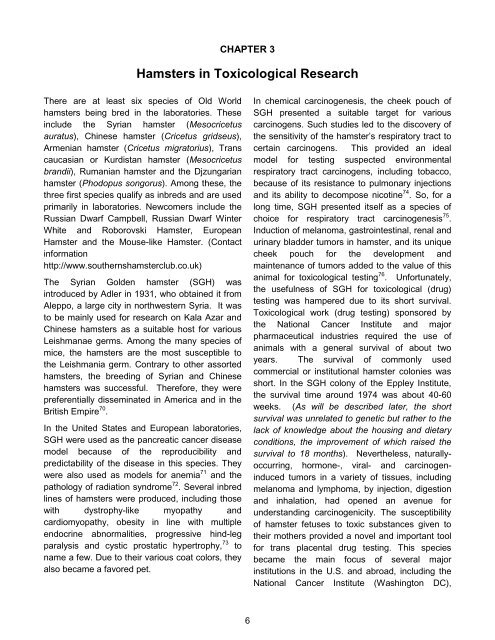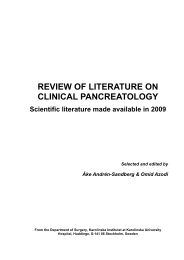Download PDF - The Pancreapedia
Download PDF - The Pancreapedia
Download PDF - The Pancreapedia
Create successful ePaper yourself
Turn your PDF publications into a flip-book with our unique Google optimized e-Paper software.
CHAPTER 3<br />
Hamsters in Toxicological Research<br />
<strong>The</strong>re are at least six species of Old World<br />
hamsters being bred in the laboratories. <strong>The</strong>se<br />
include the Syrian hamster (Mesocricetus<br />
auratus), Chinese hamster (Cricetus gridseus),<br />
Armenian hamster (Cricetus migratorius), Trans<br />
caucasian or Kurdistan hamster (Mesocricetus<br />
brandii), Rumanian hamster and the Djzungarian<br />
hamster (Phodopus songorus). Among these, the<br />
three first species qualify as inbreds and are used<br />
primarily in laboratories. Newcomers include the<br />
Russian Dwarf Campbell, Russian Dwarf Winter<br />
White and Roborovski Hamster, European<br />
Hamster and the Mouse-like Hamster. (Contact<br />
information<br />
http://www.southernshamsterclub.co.uk)<br />
<strong>The</strong> Syrian Golden hamster (SGH) was<br />
introduced by Adler in 1931, who obtained it from<br />
Aleppo, a large city in northwestern Syria. It was<br />
to be mainly used for research on Kala Azar and<br />
Chinese hamsters as a suitable host for various<br />
Leishmanae germs. Among the many species of<br />
mice, the hamsters are the most susceptible to<br />
the Leishmania germ. Contrary to other assorted<br />
hamsters, the breeding of Syrian and Chinese<br />
hamsters was successful. <strong>The</strong>refore, they were<br />
preferentially disseminated in America and in the<br />
British Empire 70 .<br />
In the United States and European laboratories,<br />
SGH were used as the pancreatic cancer disease<br />
model because of the reproducibility and<br />
predictability of the disease in this species. <strong>The</strong>y<br />
were also used as models for anemia 71 and the<br />
pathology of radiation syndrome 72 . Several inbred<br />
lines of hamsters were produced, including those<br />
with dystrophy-like myopathy and<br />
cardiomyopathy, obesity in line with multiple<br />
endocrine abnormalities, progressive hind-leg<br />
paralysis and cystic prostatic hypertrophy, 73 to<br />
name a few. Due to their various coat colors, they<br />
also became a favored pet.<br />
6<br />
In chemical carcinogenesis, the cheek pouch of<br />
SGH presented a suitable target for various<br />
carcinogens. Such studies led to the discovery of<br />
the sensitivity of the hamster’s respiratory tract to<br />
certain carcinogens. This provided an ideal<br />
model for testing suspected environmental<br />
respiratory tract carcinogens, including tobacco,<br />
because of its resistance to pulmonary injections<br />
and its ability to decompose nicotine 74 . So, for a<br />
long time, SGH presented itself as a species of<br />
choice for respiratory tract carcinogenesis 75 .<br />
Induction of melanoma, gastrointestinal, renal and<br />
urinary bladder tumors in hamster, and its unique<br />
cheek pouch for the development and<br />
maintenance of tumors added to the value of this<br />
animal for toxicological testing 76 . Unfortunately,<br />
the usefulness of SGH for toxicological (drug)<br />
testing was hampered due to its short survival.<br />
Toxicological work (drug testing) sponsored by<br />
the National Cancer Institute and major<br />
pharmaceutical industries required the use of<br />
animals with a general survival of about two<br />
years. <strong>The</strong> survival of commonly used<br />
commercial or institutional hamster colonies was<br />
short. In the SGH colony of the Eppley Institute,<br />
the survival time around 1974 was about 40-60<br />
weeks. (As will be described later, the short<br />
survival was unrelated to genetic but rather to the<br />
lack of knowledge about the housing and dietary<br />
conditions, the improvement of which raised the<br />
survival to 18 months). Nevertheless, naturallyoccurring,<br />
hormone-, viral- and carcinogeninduced<br />
tumors in a variety of tissues, including<br />
melanoma and lymphoma, by injection, digestion<br />
and inhalation, had opened an avenue for<br />
understanding carcinogenicity. <strong>The</strong> susceptibility<br />
of hamster fetuses to toxic substances given to<br />
their mothers provided a novel and important tool<br />
for trans placental drug testing. This species<br />
became the main focus of several major<br />
institutions in the U.S. and abroad, including the<br />
National Cancer Institute (Washington DC),












